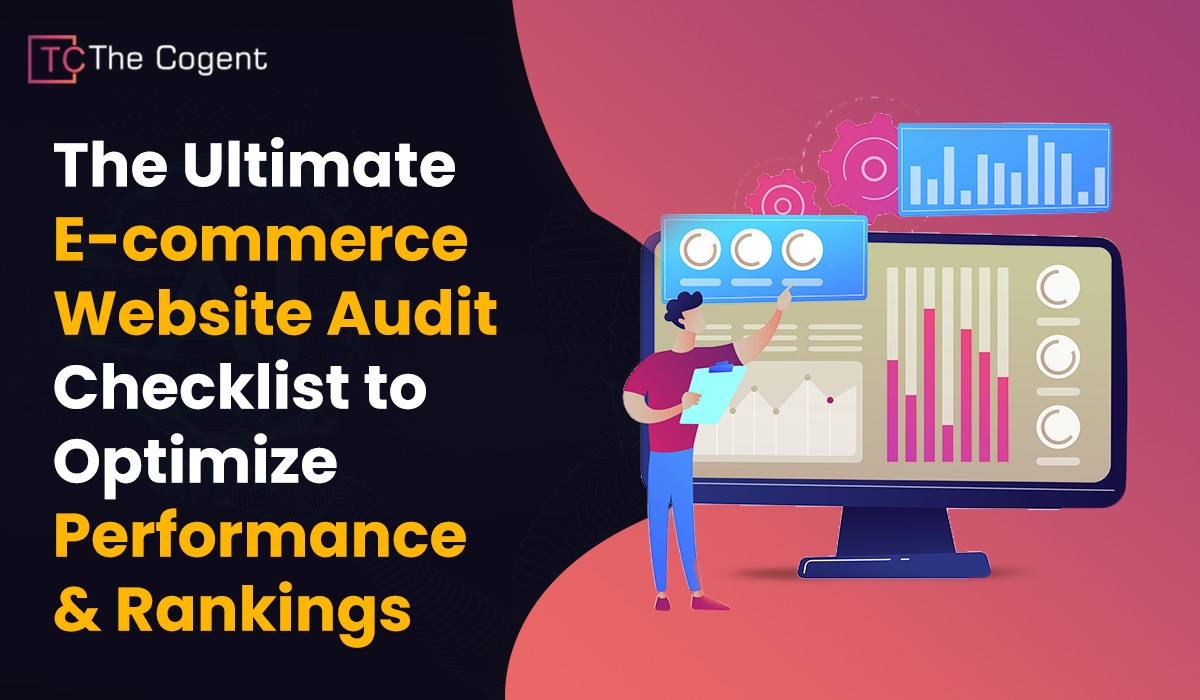Nowadays, in the digital era of high paces, it is not merely enough to open an ecommerce site. Your online store must remain in front of other competitive stores in terms of smooth running, popularity on search engines, and appealing to the user. And this is where the role of thorough ecommerce audit is involved.
An audit will help you to see what is going good and what should be improved. This guide has all that you require to test, such as, SEO, user experience and also security. So, whether you have a small ecommerce store or you are a growing online brand, this final audit checklist will be able to help you through the process of enhancing your site in order to make it work better, drive high traffic, and attract numerous conversions.
1. Technical SEO for Ecommerce Websites
Technical SEO is the foundation of the visibility of your site. The most beautiful site can never get to your audience without a good technical background.
Key areas to check:
- Site Structure and URL Hierarchy: Ensure that your site is easy to read and follow a common path will help you (e.g. Home > Category > Product). URLs must be crystal clear.
- Mobile-Friendliness: Run your site through Google Mobile Friendly Test to ascertain that it can be used in all devices. A responsive design plays an essential role.
- Page Speed: Pages that load slowly sends your visitors into rages and affects your ranking. Meet the load time using such tools as PageSpeed Insights or GTmetrix.
- Crawlability & Indexing: Crawlers try to get all the better information on the crawling of websites, so poorly configured or incorrectly blocked important pages, dangerous robots should not be stored in a robots.txt file. Monitor pages that have been indexed on Google Search Console.
- Broken Links: Internal or external broken links have adverse impact in SEO and user confidence. Fix them with the help of such tools as Screaming Frog or Ahrefs.
- Canonical Tags: Avoid creating duplicate content problems by use of correct canonical tags, particularly when it comes to products of similar pages.
2. On-Page SEO & Content Optimization
When your technical foundation has been solid, the next stage is optimizing the content on your pages in order to be more visible and relevant.
What to review:
- Title Tags & Meta Descriptions: All the products and categories should be supported by unique title and descriptions with the use of key-words.
- Header Tags (H1, H2, H3): Use headings to organize. H 1 of main title, H 2 of subheadings etc.
- Optimized image usages: Ensure a use of clean product image and the size of such images should be compressed and description should be provided using ALT tags.
- Keyword Usage: Avoid keyword stuffing. Use your primary keywords naturally in titles, content, and URLs.
- Product Descriptions: Make them unique, informative and assist in answering any questions by the buyers. That is because you should not copy-paste the content of manufacturers.
- Internal Linking: This will entail creating links to related products or blog material so that people will remain on the site and also improve crawling.
- Schema Markup: This will add structured data on products, reviews, and prices that will enhance better appearance of your site in the search results.
3. User Experience (UX) & Conversion Optimization
The battle is half done to get traffic. An excellent user experience (UX) keeps the visitor on your site and ends up buying something.
Points to audit:
- Navigation & Menus: Your navigation system on this site must be user friendly. There is logical categorization and sub-categorization of group products.
- Search Functionality: The products should be easily be found by using filters, categories or searching with the help of a bar.
- Product Pages: Make sure every product has:
- High-quality images
- Clear pricing
- Size and variant options
- Shipping and return policies
- Trust signals (like secure checkout, reviews, etc.)
- Checkout Process: It should be short and sweet. Minimize the process to follow in order to make a purchase. Make guest checkout available.
- Call-to-Actions (CTA): Plain text buttons such as: Buy Now, Add to Cart, or Learn More should be in plain view and in strategic location.
- Mobile UX: Make sure that the user can easily access your site on mobile; buttons need to be tapped on and forms interactive.
4. Functional & Performance Testing
There are cases where problems can not be seen until they are realized by a user. This is the reason why you need to test the functionality and performance of your site.
Checklist:
- Browser Compatibility: Your website must be functional on all main browsers i.e. Chrome, Safari, Firefox and Edge.
- Responsive Design: All pages must be seen correctly on the mobile phones, tablets and desktop computers.
- Check out Testing: Test purchases so that the checkout system, the payment gateway and the confirmation emails are functioning properly.
- Form functionality: Contacts, sign-ups, pop-ups and forms must gather data adequately and display thank-you messages.
- Site Downtime: Keep an eye on the uptime with such services as UptimeRobot or Pingdom. A site which keeps on crashing will land up losing clients and income.
- Third-Party Integrations: Ensure that the chatbots, analytics and payment systems are integrated and are working appropriately.
5. Analytics and Tracking for Ecommerce
You will not be able to know what is working and where users are losing out without tracking.
Here’s what to set up and monitor:
- Google Analytics: Monitor sessions, bounce rate source of traffic and most popular pages.
- Google Search Console: Track search performance of your web site and solve SEO problems.
- Ecommerce Tracking: Turn on ecommerce tracking in Google analytics to determine how products are performing, the abandonment rate of the shopping cart and conversion rate.
- Heatmaps: Hotjar or Crazy Egg are tools to get information about where users click and how users scroll.
- Goals and Funnels: Build conversion goals and funnels and be able to track flow of the user on your site.
- A/B Testing: The activity must be frequently used and it should experiment on the changes of pages with the aim of learning which page design or content is efficient.
6. Security & Compliance Review
As cyber threats get upped, your ecommerce site should be secure to your company and consumers.
What to check:
- SSL certificate: All the time your site must be HTTPS secured. This offers security of data and trust.
- Payment Security: Ensure the payment gateways are PCI-DSS compliant and provide secure check out.
- Privacy Policy & Terms: Explain your privacy policies, your returns policy and terms of use.
- Cookie Conversent: In case your audience has people in the EU, you need to have a cookie consent pop-up to comply with GDPR.
- Backups: Regularly back up your web site to exclude the data boom.
- User Data Protection: Apply protection on the data stored on the customers, i.e. keep them encrypted without unauthorized sharing.
7. Backlink & Off-Page Audit
The authority of your web site is constituted by the quality and quantity of back links you receive.
Things to review:
- Backlink Profile: Examine the existing backlinks with the help of such tools as Ahrefs or SEMrush. Delete any that is either toxic or spammy.
- Brand Mentions: Find the mentions of the brand that were not linked yet and request the websites to back it.
- Guest Posting and PR: Establishing backlinks by means of guest blogs of high-quality or PR campaigns.
- Social Signals: The social activities are not direct ranking factor but with social media, it is possible to elevate visibility.
- Local Citations: In case you cater to particular areas then it is best to have your store listed in local business directories and also maintain NAP (Name, Address, Phone number)
8. Building a Sustainable Audit Strategy
The audits should not be carried out once. It is necessary to monitor your site so that it will continue to develop and keep the performance.
Tips for ongoing audits:
- A quarterly search engine optimization check-up to stay on top of the changes in the algorithm
- Analytical assessment of performance on a monthly basis
- Reviewing the content every two weeks to renew the product descriptions or the blog articles
- Regular UX tests to be flexible in regard to customer behavior and technology changes
- Frequent security checks to remain immune to emerging threats
Be sure to write what you have found every time, rank issues and set deadlines on them.
FAQ
Ecommerce site audit means going through a comprehensive check up of all the major components that impact performance of your site such as SEO, user experience, speed, and security among others. It aims at determining what works and therefore addressing what does not work so that such an online store may perform better and improve sales.
Ideally, you need to conduct a mini-audit quarterly and full in the range of 6-12 months. Frequent audits put you ahead of trends on Google, competition, and user specifications.
Such useful tools are:
Google Analytics & Search Console
PageSpeed Insights
Screaming Frog
SEMrush / Ahrefs / Moz
Hotjar or Crazy Egg
GTmetrix
UptimeRobot
These tools provide a view on technical problems, the health of the search engine optimization, user activity, and so on.
First, do what is important with high-priority items – such as broken links, slow pages, and mobile experience. Then, renew product contents, optimize images and better navigation. Even slight changes in loading speed, checkout process, or content can tremendously increase your conversion rate.
Well-optimization ecommerce site will attract more traffic, transform visitors into customers, and establish trust in the long-run. In a very competitive world, any transportation delay of a few seconds or bad experience will cost you sales. That is why the routine of audits and updates is indeed the success determinant.
Final Thoughts
Your business is based on your ecommerce site. However, as with any other machine it requires a regular adjustment in order to work optimally. This ecommerce audit checklist helps you to identify areas of concern, fix them, and provide your customers with a better experience to increase your web page ranking by search engines.
Begin auditing now- you can start giving your store the competitive advantage that it requires.



